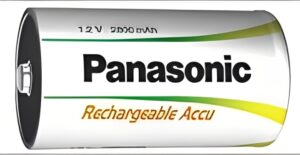Introduction: The Importance of Rechargeable D Batteries
When it comes to powering devices that require long-lasting energy, rechargeable D batteries are a top choice for consumers seeking both performance and sustainability. These versatile batteries can be used in a variety of applications, from household electronics to industrial tools. But what makes them a better option than traditional single-use batteries? In this blog, we will explore the benefits of rechargeable D batteries, their practical uses, and how they contribute to a more eco-friendly and cost-effective solution for your power needs.
What are Rechargeable D Batteries?
Rechargeable D batteries are designed to provide long-lasting power while being reusable. Unlike regular D batteries, which can only be used once, rechargeable D batteries can be charged and discharged multiple times. This makes them an excellent choice for devices that demand high energy output, such as large flashlights, toys, and portable radios.
-
Type: These batteries typically use nickel-metal hydride (NiMH) or lithium-ion (Li-ion) technology, both of which are known for their durability and ability to hold charge over many cycles.
-
Capacity: Rechargeable D batteries offer higher capacity compared to standard disposable ones, meaning they can provide more power for longer periods.
Benefits of Using Rechargeable D Batteries
Switching to rechargeable D batteries offers numerous advantages. Whether you’re using them for electronics, tools, or household gadgets, the long-term benefits make them a smart choice.
1. Cost-Effective Solution
One of the most significant benefits of rechargeable D batteries is their cost-efficiency over time. While the initial investment is higher than traditional disposable batteries, you can recharge these batteries hundreds of times, drastically reducing the need for constant replacements.
-
Save Money: Purchasing a set of rechargeable D batteries can save you money in the long run.
-
Reduced Waste: By reusing the same battery, you’re helping reduce environmental waste.
2. Eco-Friendly Choice
With increasing concerns about the environmental impact of single-use batteries, rechargeable D batteries offer an environmentally friendly solution. Unlike their disposable counterparts, they don’t end up in landfills after a single use, making them a more sustainable option for consumers who want to minimize their ecological footprint.
-
Less Waste: Rechargeable batteries reduce the demand for raw materials required to manufacture disposable batteries.
-
Lower Carbon Footprint: By using fewer disposable batteries, you’re contributing to a decrease in the carbon footprint associated with battery production and disposal.
3. High Performance for Electronics and Tools
When paired with high-drain devices, such as flashlights, radios, or tools, rechargeable D batteries maintain a consistent and reliable power output. This ensures that your devices perform at their best, without the need for frequent battery changes.
-
Longer Battery Life: Rechargeable D batteries can offer several hours of continuous power.
-
Reliable Energy: Whether you’re using them in safety tools, sensors, or connectors, rechargeable D batteries provide dependable performance over time.
Applications of Rechargeable D Batteries
1. Home Electronics
From remote controls to portable radios, rechargeable D batteries power a wide range of electronics around the house. Their ability to be recharged makes them an ideal solution for homeowners who want to reduce battery waste.
-
Flashlights: Rechargeable D batteries are widely used in flashlights, especially heavy-duty ones.
-
Toys: Many children’s toys require high-power batteries, making rechargeable D batteries a great fit.
2. Power Tools
For tools such as power drills, rechargeable D batteries provide long-lasting, reliable energy. The rechargeable nature of these batteries is essential in heavy-duty tasks where high energy output is required over extended periods.
-
Durability: Rechargeable D batteries are ideal for use in power tools, providing long-lasting performance for hours of continuous use.
-
Efficiency: These batteries help ensure that your tools work optimally, without interruption from constant battery replacement.
3. Industrial Applications
In sensors, connectors, contactor systems, and other industrial tools, rechargeable D batteries are an essential part of maintaining efficient operations. Their ability to handle high-drain tasks, such as thermal sensors and fuses, ensures that industrial equipment remains powered for extended periods.
-
Sensors: Used in industrial sensors to monitor and control machinery operations.
-
Industrial Safety: Rechargeable D batteries ensure that critical safety equipment remains operational during emergencies.
How to Choose the Right Rechargeable D Battery
When selecting rechargeable D batteries, it’s important to consider factors like capacity, voltage, and battery chemistry. Here’s a breakdown of key considerations:
1. Capacity and Voltage
-
Voltage: Most rechargeable D batteries have a nominal voltage of 1.2V, lower than the 1.5V offered by disposable D batteries. However, they still provide reliable power for most devices.
-
Capacity: Look for batteries with higher mAh ratings for longer-lasting power.
2. Chemistry: NiMH vs. Li-ion
-
Nickel-Metal Hydride (NiMH): Offers a good balance between capacity and cost. It’s commonly used in consumer electronics and household devices.
-
Lithium-Ion (Li-ion): Known for higher energy density, longer life, and lighter weight. It’s suitable for high-power applications like power tools and safety devices.
Conclusion: The Future of Rechargeable D Batteries
The demand for rechargeable D batteries is expected to grow as consumers become more environmentally conscious and seek cost-effective solutions. With a wide range of applications in , tools, and industrial systems, they are a practical choice for those looking to save money and reduce waste.


